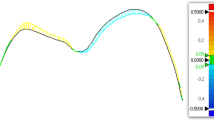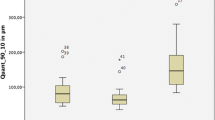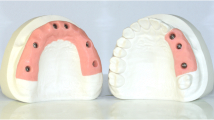Abstract
Objectives
This study aimed to evaluate the accuracy of intraoral scanners in full-arch scans.
Materials and methods
A representative model with 14 prepared abutments was digitized using an industrial scanner (reference scanner) as well as four intraoral scanners (iTero, CEREC AC Bluecam, Lava C.O.S., and Zfx IntraScan). Datasets obtained from different scans were loaded into 3D evaluation software, superimposed, and compared for accuracy. One-way analysis of variance (ANOVA) was implemented to compute differences within groups (precision) as well as comparisons with the reference scan (trueness). A level of statistical significance of p < 0.05 was set.
Results
Mean trueness values ranged from 38 to 332.9 μm. Data analysis yielded statistically significant differences between CEREC AC Bluecam and other scanners as well as between Zfx IntraScan and Lava C.O.S. Mean precision values ranged from 37.9 to 99.1 μm. Statistically significant differences were found between CEREC AC Bluecam and Lava C.O.S., CEREC AC Bluecam and iTero, Zfx Intra Scan and Lava C.O.S., and Zfx Intra Scan and iTero (p < 0.05).
Conclusions
Except for one intraoral scanner system, all tested systems showed a comparable level of accuracy for full-arch scans of prepared teeth. Further studies are needed to validate the accuracy of these scanners under clinical conditions.
Clinical relevance
Despite excellent accuracy in single-unit scans having been demonstrated, little is known about the accuracy of intraoral scanners in simultaneous scans of multiple abutments. Although most of the tested scanners showed comparable values, the results suggest that the inaccuracies of the obtained datasets may contribute to inaccuracies in the final restorations.






Similar content being viewed by others
References
Quaas S, Rudolph H, Luthardt RG (2007) Direct mechanical data acquisition of dental impressions for the manufacturing of CAD/CAM restorations. J Dent 35(12):903–908
Schoenbaum TR (2010) Decoding CAD/CAM and digital impression units. Dent Today 29(2):140, 142, 144–145
Clancy JM, Scandrett FR, Ettinger RL (1983) Long-term dimensional stability of three current elastomers. J Oral Rehabil 10(4):325–333
Endo T, Finger WJ (2006) Dimensional accuracy of a new polyether impression material. Quintessence Int 37(1):47–51
Jamani KD, Harrington E, Wilson HJ (1989) Rigidity of elastomeric impression materials. J Oral Rehabil 16(3):241–248
Shafa S, Zaree Z, Mosharraf R (2008) The effects of custom tray material on the accuracy of master casts. J Contemp Dent Pract 9(6):49–56
Shetty P, Rodrigues S (2006) Accuracy of elastomeric impression materials on repeated pours. J Indian Prosthodont Soc 6(2):61–71
Wostmann B, Rehmann P, Balkenhol M (2009) Accuracy of impressions obtained with dual-arch trays. Int J Prosthodont 22(2):158–160
Zweig A (2009) Improving impressions: go digital! Dent Today 28(11):100, 102, 104
Christensen GJ (2008) Will digital impressions eliminate the current problems with conventional impressions? J Am Dent Assoc 139(6):761–763
Christensen GJ (2009) Impressions are changing: deciding on conventional, digital or digital plus in-office milling. J Am Dent Assoc 140(10):1301–1304
Ender A, Mehl A (2011) Full arch scans: conventional versus digital impressions—an in-vitro study. Int J Comput Dent 14(1):11–21
Luthardt RG, Loos R, Quaas S (2005) Accuracy of intraoral data acquisition in comparison to the conventional impression. Int J Comput Dent 8(4):283–294
van der Meer WJ, Andriessen FS, Wismeijer D, Ren Y (2012) Application of intra-oral dental scanners in the digital workflow of implantology. PLoS One 7(8):e43312. doi:10.1371/journal.pone.0043312
Ender A, Mehl A (2013) Accuracy of complete-arch dental impressions: a new method of measuring trueness and precision. J Prosthet Dent 109(2):121–128. doi:10.1016/S0022-3913(13)60028-1
Mehl A, Ender A, Mormann W, Attin T (2009) Accuracy testing of a new intraoral 3D camera. Int J Comput Dent 12(1):11–28
Guth JF, Keul C, Stimmelmayr M, Beuer F, Edelhoff D (2012) Accuracy of digital models obtained by direct and indirect data capturing. Clin Oral Investig. doi:10.1007/s00784-012-0795-0
Seelbach P, Brueckel C, Wostmann B (2012) Accuracy of digital and conventional impression techniques and workflow. Clin Oral Investig. doi:10.1007/s00784-012-0864-4
Babayoff N, Glaser-Inbari I (2000) Imaging a three-dimensional structure by confocal focussing an array of light beams. International Publication WO 00/08415
Birnbaum NS, Aaronson HB, Stevens C, Cohen B (2009) 3D digital scanners: a high-tech approach to more accurate dental impressions. Insid Dent 5:70–74
Wachman ES, Niu W, Farkas DL (1997) AOTF microscope for imaging with increased speed and spectral versatility. Biophys J 73(3):1215–1222
Brandestini M, Moermann WH (1989) Method of and apparatus for making a prosthesis, especially a dental prosthesis. US Patent 4663720
Schwotzer A (2007) Measuring device and method that operates according to the basic principles of confocal microscopy. US Patent 2007/0296959
Thiel F, Pfeiffer J, Fornoff P (2008) Apparatus and method for optical 3D measurement. International Publication WO 2008/092791
Schmidt V (2010) 3D dental camera for recording surface structures of a measuring object by means of triangulation. International Publication WO 2010/012838 A1
Seitz G, Tiziani HJ (1996) Resolution limits of active triangulation systems by defocusing. Opt Eng 32(6):1374–1383
Kovács T (2004) Active triangulation scanner development focusing on the accuracy of the detection. In: 5th International Symposium of Hungarian Researchers: Sponsored by IEEE Computational Intelligence Chapter, Budapest, Magyarország, 2004.11.11–2004.11.12. pp 183–194
Logozzo S, Franceschini G, Kilpelä A, Caponi M, Governi L, Blois L (2011) A comparative analysis of intraoral 3D digital scanners for restorative dentistry. Internet J Med Technol 5(1). http://ispub.com/IJMT/5/1/10082
Berner M (2010) Optical system for a confocal microscope. US Patent 2010/0085636
Figerio F (2006) 3-dimensional surface imaging using active wavefront sampling (PhD Thesis). Massachusetts Institute of Technology, Massachusetts, USA. http://dspace.mit.edu/handle/1721.1/38258
Besl PJ, McKay ND (1992) A method for registration of 3-D shapes. In: IEEE Transactions on Pattern Analysis and Machine Intelligence. 14(2):239–256
Yang C, Medioni G (1992) Object modeling by registration of multiple range images. Image Vis Comput 10(3):145–155
Mada SK, Smith ML, Smith LN, Midha PS (2003) Overview of passive and active vision techniques for hand-held 3D data acquisition. In: Shearer A, Murtagh FD, Mahon J, Whelan PF (eds) Opto-Ireland 2002: Optical metrology, imaging, and machine vision, Galway, Ireland, 2002. SPIE Digital Library. http://proceedings.spiedigitallibrary.org/proceeding.aspx?articleid=879224
Acknowledgment
The authors would like to express their gratitude to Sirona (Bensheim, Germany), 3M ESPE (St. Paul, USA), Cadent Inc. (Carlstadt, USA), and Zfx GmbH (Dachau, Germany) for providing intraoral scanners. Furthermore, the authors want to thank MDT Siegbert Witkowski and MDT Wolf Woerner (Freiburg, Germany) for their help in data processing.
Conflict of interest
The authors have no conflict of interest.
Author information
Authors and Affiliations
Corresponding author
Rights and permissions
About this article
Cite this article
Patzelt, S.B.M., Emmanouilidi, A., Stampf, S. et al. Accuracy of full-arch scans using intraoral scanners. Clin Oral Invest 18, 1687–1694 (2014). https://doi.org/10.1007/s00784-013-1132-y
Received:
Accepted:
Published:
Issue Date:
DOI: https://doi.org/10.1007/s00784-013-1132-y




